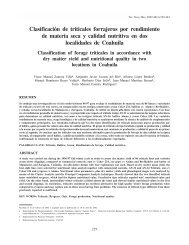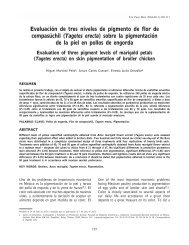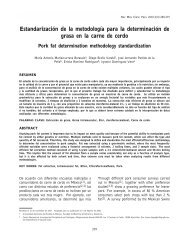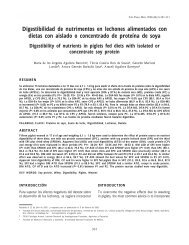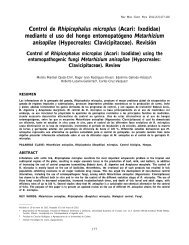Descargar documento PDF
Descargar documento PDF
Descargar documento PDF
Create successful ePaper yourself
Turn your PDF publications into a flip-book with our unique Google optimized e-Paper software.
Roger Iván Rodríguez-Vivas et al. / Rev Mex Cienc Pecu 2012;3(Supl 1):9-24<br />
la alteración de otras enzimas (46) .<br />
Li et al (71) llevaron al cabo estudios de sinergia<br />
con coumaphos y butóxido de piperonilo (PBO),<br />
un inhibidor de la oxidasa mixta citocromo P450;<br />
para estudiar mecanismos de resistencia a OPs en<br />
las cepas Muñoz (sensible) y San Román<br />
(resistente) de R. (B). microplus. Los estudios<br />
mostraron que la toxicidad de coumaphos en<br />
presencia de PBO se redujo 2-veces en la cepa<br />
Muñoz susceptible a OP, pero se incrementó 3veces<br />
en la cepa San Romano resistente a OP. En<br />
estudios paralelos con el diazinón OPs, PBO<br />
nuevamente se redujo significativamente la<br />
toxicidad de OPs en la cepa Muñoz susceptible.<br />
Sin embargo, en la cepa San Román resistente a<br />
OPs, la toxicidad de diazinón no fue afectada por<br />
PBO, un contraste con los resultados del<br />
coumaphos. Li et al (71) lanzaron la hipótesis de<br />
que la actividad del citocromo P450 responsable<br />
para bioactivación del coumaphos o el diazinón<br />
es perjudicada por el PBO en todas las cepas, y<br />
por consecuencia, en la disminución de la<br />
toxicidad de coumaphos o diazinón cuando se<br />
aplican junto con PBO. Recientemente, Miller et<br />
al (22) encontraron una cepa mexicana de de R.<br />
(B). microplus altamente resistente al diazinón<br />
pero no muy resistente a coumaphos. Cuando se<br />
expuso a coumaphos y PBO o triphenylphosphate<br />
(otro inhibidor del citocromo P450), la toxicidad<br />
se redujo entre 3.5- y 6.3-veces,<br />
respectivamente; sugiriendo que mono oxigenasas<br />
o esterases participaron en la resistencia a<br />
coumaphos. Otro estudio reciente (72) demostró la<br />
vinculación entre una mayor actividad de<br />
monooxigenasa y resistencia al acaricida<br />
piretroide en R. (B). microplus de México.<br />
Glutatión S-transferasa (GSTs): GSTs son un<br />
grupo de enzimas que catalizan la conjugación<br />
entre glutatión (GSH) y otras moléculas. Estas<br />
enzimas tienen un papel central en la<br />
desintoxicación de compuestos xenobióticos y<br />
endógenos. En poblaciones con una larga historia<br />
de exposición a productos químicos, se asocia<br />
una alta actividad de GST con resistencia a los<br />
insecticidas (73) . Resistencia a los OCs y OPs está<br />
asociada específicamente con una mayor<br />
actividad de GST (74,75) . Estos hechos sugieren que<br />
la conjugación del insecticida al glutatión, que es<br />
catalizada por GST, puede ser un mecanismo de<br />
20<br />
coumaphos or diazinon is adversely affected by<br />
PBO in all strains, leading to the decline in<br />
toxicity when either coumaphos or diazinon are<br />
applied with PBO. Recently, Miller et al (22) found<br />
a Mexican R. (B.) microplus strain highly<br />
resistant to diazinon but not highly resistant to<br />
coumaphos. When exposed to coumaphos and<br />
PBO or triphenylphosphate (another inhibitor of<br />
cytochrome P450), the toxicity was reduced by<br />
3.5- and 6.3-fold, respectively, suggesting that<br />
mono-oxygenases and/or esterases were involved<br />
in resistance to coumaphos. Another recent<br />
study (72) showed a linkage between increased<br />
monooxygenase activities and pyrethroid<br />
acaricide resistance in R. (B.) microplus from<br />
Mexico.<br />
Glutathione S-Transferases (GSTs): GSTs are a<br />
group of enzymes that catalyze the conjugation<br />
between glutathione (GSH) and several<br />
molecules. These enzymes have a central role in<br />
detoxification of xenobiotic and endogenous<br />
compounds. In populations with a long history of<br />
chemical exposure, high GST activity is<br />
associated with resistance to insecticides (73) .<br />
Resistance to OCs and OPs is specifically<br />
associated with increased GST activity (74,75) .<br />
These facts suggest that insecticide conjugation to<br />
glutathione, which is catalyzed by GST, may be a<br />
detoxification mechanism in arthropods (76) . He et<br />
al (77) reported the purification, characterization,<br />
and molecular cloning of a larval R. (B.)<br />
microplus GST. Synergist bioassays on several<br />
amitraz-resistant strains from Mexico and one<br />
Brazilian strain of R. (B.) microplus indicated<br />
some involvement of esterase and glutathione Stransferase<br />
(79) .<br />
CONCLUSIONS<br />
Current tick-control methods involve use of nonchemical<br />
and chemical methods. Although the<br />
control of ticks relies heavily on the use of<br />
chemicals, the development of R. (B.) microplus<br />
resistant to these compounds is a serious threat<br />
worldwide. The development of acaricide<br />
resistance in a tick population is dependent on the<br />
frequency of occurrence of resistant individuals<br />
in the population and the intensity of chemical<br />
selection pressure. R. (B.) microplus resistant to<br />
OPs, SPs and amitraz has been reported



